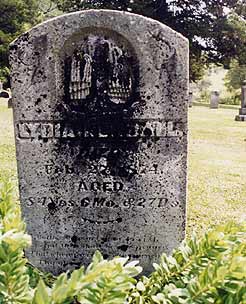 (First in a sporadic series, probably)
(First in a sporadic series, probably)You can verify birth dates, land ownership, etc. -- but how do you find out what your ancestors were really
like? Did they have a sense of humor? Were they good parents? What did they like to do in their free time? Did they
have any free time?
Lydia Bickett Kendall, my great-great-great-grandmother, was a little girl when her family sailed to America from Ireland in the 1790s. She grew up, moved from Pennsylvania to Ohio and Illinois, got married, had kids, was widowed early, died at age 84. But I want to know what she was
like.
Martha Ann Kendall Jones,the 1889 family historian, describes her as "a cheerful, happy-hearted Godly woman, kind to all, and tender-hearted to her dear children..." which is lovely, but dear Martha has only nice things to say about everybody in the family, so I'd like a little more evidence.
Lydia was 45 when her husband died, leaving her with four children under the age of 10. When her sons were old enough they bought farms next to each other and she lived with them the rest of her life. Her oldest son William was 43 when he married. Was marrying late a family tradition? Or was Lydia one of those controlling matriarchs who never let her kids grow up and ruled the family with an iron hand?
I visited Monmouth, Illinois, where Lydia is buried, and found her tombstone. (If you have ancestors from Warren County, Illinois, lucky you! They have the friendliest, most helpful genealogy folks there.) The stones are worn in the old section of the Sugar Tree Grove Cemetery, but Lydia's is larger than the rest of the family stones, and is the only one in the old section with a plant on it (sedum -- no idea who put it there or how long it's been there.)
So why did she get the biggest stone? Did she order it ahead of time and her browbeaten children carried out her grandiose orders to the last? Or was it a real tribute to someone they valued and loved?
The stone reads "Lydia Kendall, Died Feb. 27, 1874, Aged 84 Yrs, 6 Mo & 27 Ds." Predictable. But at the bottom is a long, mostly unreadable poem. Can't make out the complete contents but it's definitely a sentimental tribute to Mother.
We'll never know for sure, but I'm betting she really was a pretty nice person with a family who really loved her.





